Cards: Action Packed Rookies 1991, GameDay 1992
Acquired: TTM 2010, C/o The Forever Young Foundation
Sent: 6/11/10 Received: 6/17/10 (6 days. Donation suggested)
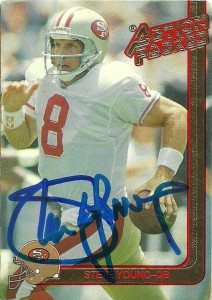 From what I understand, Steve Young has been rumored to be an ‘autopenner’. Autopenning is a relatively new and ruthless thing that players can do to fans hoping for an authentic autograph from them. An autopen is a machine that will line up the card and simulate the player’s signature. While I’m not sure what to think of this, many fans decry it because it lessens the interaction between the fan and the player and thus- it is not authentic. I could see how this would anger somebody who had his rookie card and really wanted him to sign it but for these two cards, it wouldn’t really bother me either way.
From what I understand, Steve Young has been rumored to be an ‘autopenner’. Autopenning is a relatively new and ruthless thing that players can do to fans hoping for an authentic autograph from them. An autopen is a machine that will line up the card and simulate the player’s signature. While I’m not sure what to think of this, many fans decry it because it lessens the interaction between the fan and the player and thus- it is not authentic. I could see how this would anger somebody who had his rookie card and really wanted him to sign it but for these two cards, it wouldn’t really bother me either way.
GameDay came onto the scene in 1992. That along with Skybox and Action Packed were about all I’d collect before I stopped buying football cards during the 1993 season. From there on out my card collecting became sporadic and based solely on teams and players I wanted. GameDay had some really nice cards with their unique design that represented a ticket. The frames are cropped in just a certain way that the players would appear to burst right off the card edge and this Steve Young card is an exceptional example.
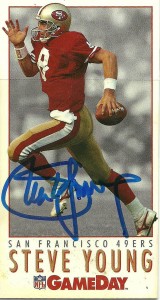 Steve Young is another player who just got no respect- but in his case, he went out and proved them all wrong. As you can tell from these two cards, Steve Young is doing what he does best- run. After graduating from BYU, Steve Young signed a then record 10 year 40 million dollar contract with the Los Angeles Express of the USFL. He’d lead the team to the playoffs his rookie season but in 1985 the league financially hemorrhaged.
Steve Young is another player who just got no respect- but in his case, he went out and proved them all wrong. As you can tell from these two cards, Steve Young is doing what he does best- run. After graduating from BYU, Steve Young signed a then record 10 year 40 million dollar contract with the Los Angeles Express of the USFL. He’d lead the team to the playoffs his rookie season but in 1985 the league financially hemorrhaged.
Steve would be the first player selected in the USFL supplemental draft by the Tampa Bay Buccaneers. After a rough 2 seasons with the Bucs, the 49ers would pull the trigger and trade for the beleaguered quarterback after Tampa Bay drafted Vinny Testaverde with the first pick of the 1987 draft. Young was considered a loose cannon on the field by Tampa. Forced to improvise due to a patchwork line, Steve would frequently scramble, and in two seasons had only won 3 games in 19 starts. For points and purposes he was a bust and discarded for a 2nd and 4th round choice from the Niners.
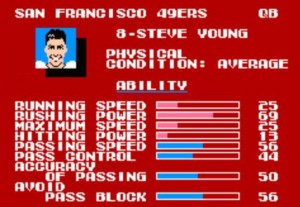 Steve’s rebirth would begin in San Fransisco as future HoFer Joe Montana’s backup. He’d become the league’s best insurance premium, tutored by coaching wiz Bill Walsh and his offensive staff. As Young would bide his time, Montana’s age and frailty would emerge, and at some points a quarterback controversy would emerge. In 1991 after Montana was sidelined for the season, it was largely believed that this was Young’s shot at being the team’s starter, but after injury and relative ineffectiveness- Young would be locked in a quarterback controversy with Steve Bono briefly losing the job to him. He would recover the starting job, but the team only won 10 games and missed the playoffs.
Steve’s rebirth would begin in San Fransisco as future HoFer Joe Montana’s backup. He’d become the league’s best insurance premium, tutored by coaching wiz Bill Walsh and his offensive staff. As Young would bide his time, Montana’s age and frailty would emerge, and at some points a quarterback controversy would emerge. In 1991 after Montana was sidelined for the season, it was largely believed that this was Young’s shot at being the team’s starter, but after injury and relative ineffectiveness- Young would be locked in a quarterback controversy with Steve Bono briefly losing the job to him. He would recover the starting job, but the team only won 10 games and missed the playoffs.
Young would respond by leading the team to the NFC Championship game the next season in 1993, and was named the league’s offensive MVP. Despite his accomplishments, Young would still have to suffer with fans and the owner expressing their desire to see Montana return to the starting role.
With Bono and Young in the fold at the beginning of 1994 though, Montana was expendable to the 49ers and they traded him to greener pastures in Kansas City ending all controversy. Steve would lead the 49ers to SuperBowl victory at the conclusion of the season and was named NFL MVP again setting an NFL record completing over 70% of his passes.
With Young under center the 49ers always were a threat while consistently making the playoffs throughout the 1990s, but Steve suffered multiple concussions due to his competitive style, 290 sacks, and refusal to dive with his feet. He’d retire at the conclusion of the 1999 season, refusing an offer to join Mike Shannahan in Denver. After posting a 3-16 record in Tampa, Young would go 91-33 with the 49ers.
Since football, Steve has remained active in his charity “The Forever Young Foundation”- which serves children who face significant physical, emotional, and financial challenges by providing academic, athletic, and therapeutic opportunities unavailable to them. He is also a commentator on the NFL draft and also ESPN. He is avidly involved in Utah Sports and is the great-great-great grandson of Brigham Young.
Steve was inducted into the Pro Football Hall of Fame in 2005, and had his number retired by the 49ers bringing his career full circle. Winner of 6 passing titles, a then record 112.8 passer rating, the Super Bowl MVP of XXIX, (throwing a record 6 touchdowns)- Young was an AP 4 times, MVP twice and named to 7 Pro Bowls over his career to go along with numerous passing titles repeated 4 times over. Steve is also recognized as the NFL career leader in rushing touchdowns with 43, (although Otto Graham finished with 44, but the old AAFL’s statistics were not accepted into the NFL statistic books.)
G/Gs 169/143 Att 4149 Comp 2667 Yds 33124 Pct 64.3 Td 232 Int 107 Rat 96.8 |
Rush 722 Yds 4239 Avg 5.9 Td 43 Lg 49
Retrospect video of Young’s career: http://www.nfl.com/videos/nfl-game-highlights/09000d5d80130084/Hall-of-Fame-Steve-Young
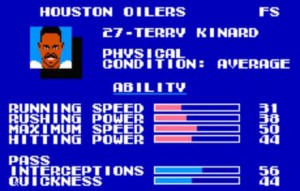 Card: Score Supplemental 1990
Card: Score Supplemental 1990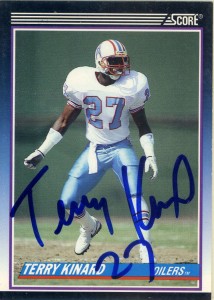
 From what I understand, Steve Young has been rumored to be an ‘autopenner’. Autopenning is a relatively new and ruthless thing that players can do to fans hoping for an authentic autograph from them. An autopen is a machine that will line up the card and simulate the player’s signature. While I’m not sure what to think of this, many fans decry it because it lessens the interaction between the fan and the player and thus- it is not authentic. I could see how this would anger somebody who had his rookie card and really wanted him to sign it but for these two cards, it wouldn’t really bother me either way.
From what I understand, Steve Young has been rumored to be an ‘autopenner’. Autopenning is a relatively new and ruthless thing that players can do to fans hoping for an authentic autograph from them. An autopen is a machine that will line up the card and simulate the player’s signature. While I’m not sure what to think of this, many fans decry it because it lessens the interaction between the fan and the player and thus- it is not authentic. I could see how this would anger somebody who had his rookie card and really wanted him to sign it but for these two cards, it wouldn’t really bother me either way. Steve Young is another player who just got no respect- but in his case, he went out and proved them all wrong. As you can tell from these two cards, Steve Young is doing what he does best- run. After graduating from BYU, Steve Young signed a then record 10 year 40 million dollar contract with the Los Angeles Express of the USFL. He’d lead the team to the playoffs his rookie season but in 1985 the league financially hemorrhaged.
Steve Young is another player who just got no respect- but in his case, he went out and proved them all wrong. As you can tell from these two cards, Steve Young is doing what he does best- run. After graduating from BYU, Steve Young signed a then record 10 year 40 million dollar contract with the Los Angeles Express of the USFL. He’d lead the team to the playoffs his rookie season but in 1985 the league financially hemorrhaged. Steve’s rebirth would begin in San Fransisco as future HoFer Joe Montana’s backup. He’d become the league’s best insurance premium, tutored by coaching wiz Bill Walsh and his offensive staff. As Young would bide his time, Montana’s age and frailty would emerge, and at some points a quarterback controversy would emerge. In 1991 after Montana was sidelined for the season, it was largely believed that this was Young’s shot at being the team’s starter, but after injury and relative ineffectiveness- Young would be locked in a quarterback controversy with
Steve’s rebirth would begin in San Fransisco as future HoFer Joe Montana’s backup. He’d become the league’s best insurance premium, tutored by coaching wiz Bill Walsh and his offensive staff. As Young would bide his time, Montana’s age and frailty would emerge, and at some points a quarterback controversy would emerge. In 1991 after Montana was sidelined for the season, it was largely believed that this was Young’s shot at being the team’s starter, but after injury and relative ineffectiveness- Young would be locked in a quarterback controversy with 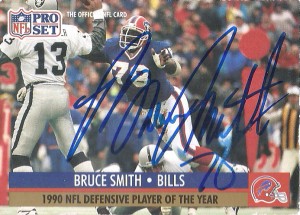
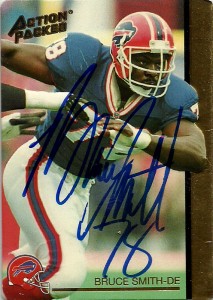 Highly decorated coming out of college at Virginia Tech, Bruce Smith was a shoe in #1 pick being named the Outland Trophy winner in 1984 and a 2 time All American in 1983, and 1984. Drafted by the Buffalo Bills, Bruce quickly established himself as an outside rushing force and within 5 seasons had become the all time sack leader of the franchise. In 1990 he made 19 sacks, and was named NFL defensive MVP. Bruce would lose his 1991 season to a knee injury but would return in full force by 1992. He would transition from a 3-4 to a 4-3 defense successfully under then defensive coordinator Wade Phillips later in 1995, where he again would be named defensive MVP in 1996. He would be allowed to sign via Free Agency in 1999 where he became more of a designated pass rusher, and passed up
Highly decorated coming out of college at Virginia Tech, Bruce Smith was a shoe in #1 pick being named the Outland Trophy winner in 1984 and a 2 time All American in 1983, and 1984. Drafted by the Buffalo Bills, Bruce quickly established himself as an outside rushing force and within 5 seasons had become the all time sack leader of the franchise. In 1990 he made 19 sacks, and was named NFL defensive MVP. Bruce would lose his 1991 season to a knee injury but would return in full force by 1992. He would transition from a 3-4 to a 4-3 defense successfully under then defensive coordinator Wade Phillips later in 1995, where he again would be named defensive MVP in 1996. He would be allowed to sign via Free Agency in 1999 where he became more of a designated pass rusher, and passed up 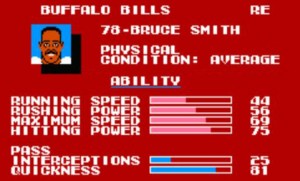 I had heard that Bruce was a great TTM signer, but I couldn’t believe it till I tried it since he was the NFL’s career sack leader. He responded in very little time via the Pro Football HoF (Canton,OH) roughly in 30 days. Always well represented in Tecmo Super Bowls, Bruce when he was in excellent condition would dominate any offensive lineman and on occasion was so fast could cover wide receivers down the field, and 9 times out of 10 his quickness allowed him to be around any play with the computer.
I had heard that Bruce was a great TTM signer, but I couldn’t believe it till I tried it since he was the NFL’s career sack leader. He responded in very little time via the Pro Football HoF (Canton,OH) roughly in 30 days. Always well represented in Tecmo Super Bowls, Bruce when he was in excellent condition would dominate any offensive lineman and on occasion was so fast could cover wide receivers down the field, and 9 times out of 10 his quickness allowed him to be around any play with the computer.